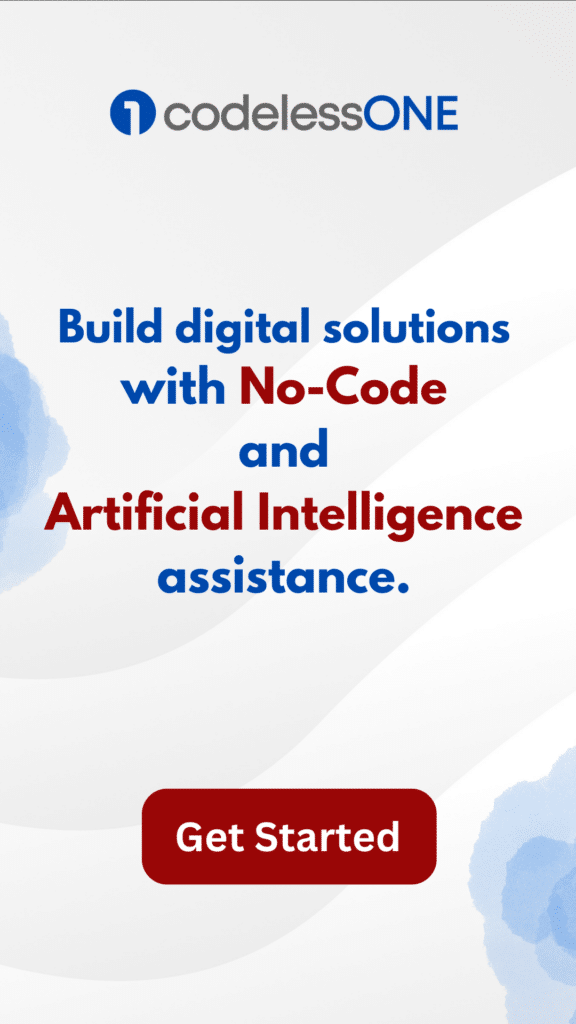No-code and Low Code Trends and Predictions in 2024.

Share:
Table of Contents
In today’s rapidly evolving digital landscape, businesses continually seek innovative ways to streamline operations, enhance their products, and respond swiftly to market changes. No-code technology has emerged as a transformative force in software development, allowing organizations to create applications and automate processes without traditional coding skills.
The global market for low-code and no-code development technologies is forecasted to achieve a total worth of $26.9 billion in 2023.
In this report, we will explore the future trends and predictions for no-code technology, examining its impact on various facets of the business landscape.
Empowered Workforce
The concept of “citizen developers” is on the rise, signifying employees who lack formal coding backgrounds but can use no-code platforms to create applications. Organizations are increasingly investing in upskilling their employees to harness the potential of no-code technology. This trend empowers individuals from various departments to participate in innovation and problem-solving. No-code development can cut application building costs by 70 percent.
The impact of citizen developers on organizations is substantial:
Increased Innovation: Citizen developers contribute fresh ideas and solutions, fostering innovation throughout the organization.
Reduced IT Dependency: With citizen developers, organizations can reduce their reliance on IT departments for routine development tasks.
Efficiency: Empowering employees to build their own solutions streamlines processes and reduces bottlenecks.
Cross-Functional Collaboration: Citizen developers encourage collaboration between technical and non-technical teams, resulting in more well-rounded solutions.
Seamlessness in Integration
No-code tools are continually enhancing their integration capabilities, allowing organizations to connect various systems, applications, and data sources seamlessly. This will enable a more holistic and unified approach to digital transformation.
Seamless integration benefits organizations in numerous ways:
Enhanced Data Accessibility: Integration enables organizations to access and utilize data from disparate sources effectively.
Process Streamlining: Automation and integration lead to more efficient and streamlined business processes.
Improved Decision-Making: A comprehensive view of data from multiple sources supports better-informed decision-making.
Customer-Centric Solutions: Integrated data helps in delivering personalized and customer-centric solutions.
Accelerated adoption by enterprises
Enterprises are increasingly recognizing the value of no-code development in driving digital transformation. No-code adoption is poised to accelerate as organizations seek to be more agile and responsive to market demands. No-code empowers businesses to develop digital solutions and applications rapidly, reducing the reliance on time-consuming and costly traditional development methods. As organizations embrace the adoption of no-code platforms, they are poised to experience several significant benefits:
Faster Time-to-Market: No-code enables rapid development, allowing businesses to bring products to market faster.
Cost-Efficiency: Traditional coding often involves extensive development teams and resources. No-code significantly reduces costs, making it an attractive option for cost-conscious enterprises.
Agility: No-code allows organizations to adapt quickly to changing market conditions, providing the agility needed for success in today’s business environment.
Enhanced Collaboration: Non-technical teams can actively participate in the development process, fostering a culture of collaboration and innovation.
Tailored Digital Solutions
Industry-specific solutions can be designed using no-code, to meet the unique needs of various sectors, such as healthcare, finance, and manufacturing. This specialization expedites digital transformation within these industries.
Industry-specific solutions offer a range of benefits:
Faster Deployment: Pre-built industry templates and workflows reduce development time.
Compliance: Industry-specific solutions often come with built-in compliance features.
Customization: Despite being industry-specific, these solutions can still be highly customizable to accommodate specific business requirements.
Competitive Advantage: Organizations gain a competitive edge by adopting solutions tailored to their industry’s challenges.
Fast Prototyping
No-code technology facilitates rapid prototyping, allowing organizations to experiment with ideas and gather user feedback quickly. This iterative approach fosters more innovative and user-centric product development. Business Technologists, Hyperautomation and Composability Will Drive Low-Code Technology Adoption Through 2026.
Rapid prototyping has several significant advantages:
Reduced Risk: Prototyping allows organizations to test ideas with minimal investment, reducing the risk of costly development mistakes.
User-Centric Design: Frequent prototyping and user feedback lead to more user-centric product design.
Agile Development: The ability to quickly iterate and refine prototypes aligns with agile development methodologies.
Time and Cost Savings: Faster prototyping results in reduced development time and costs.
Enhanced User Experiences
Users can experience enhanced capabilities for customization and personalization. This empowers organizations to create tailored user experiences, leading to improved customer satisfaction and loyalty.
Customization and personalization bring several advantages:
Enhanced User Engagement: Tailored experiences resonate better with users, increasing engagement.
Improved Conversion Rates: Personalized content and features can lead to higher conversion rates.
Data-Driven Personalization: No-code platforms leverage data to inform personalization decisions, making them more effective.
Competitive Edge: Customized experiences differentiate organizations from competitors.
AI-Powered No-Code Solution
The integration of artificial intelligence (AI) and automation into no-code platforms is becoming increasingly prevalent. This enables the automation of complex tasks, decision-making processes, and predictive analytics.
AI and automation offer several advantages within no-code environments:
Efficiency: AI automates repetitive tasks, boosting overall efficiency.
Intelligent Recommendations: AI-driven solutions provide intelligent recommendations based on data analysis.
Predictive Analytics: No-code platforms with AI capabilities enable predictive analytics, helping organizations anticipate trends and make informed decisions.
Accessibility: AI integration is designed to be accessible to non-technical users.
Comprehensive Automation
No-code platforms are evolving to offer comprehensive workflow automation capabilities. This empowers organizations to automate entire business processes from start to finish, resulting in greater efficiency and reduced manual intervention.
Comprehensive workflow automation has numerous advantages:
Error Reduction: Automation minimizes human errors and improves process accuracy.
Time Savings: Automated workflows accelerate processes, reducing time-to-completion.
Resource Optimization: Employees can focus on strategic tasks instead of repetitive, manual work.
Consistency: Automation ensures that processes are executed consistently, adhering to defined rules and standards.
Robust Security Measures
No-code applications and software focus on security and compliance features to ensure that applications built using these platforms meet regulatory requirements and maintain data integrity.
Robust security and compliance measures offer several critical benefits:
Data Protection: Security measures, such as encryption and access controls, protect sensitive information.
Compliance Simplification: No-code platforms often provide compliance templates and tools, simplifying adherence to industry regulations.
Risk Mitigation: Implementing strong security and compliance measures reduces the risk of data breaches and legal penalties.
Trust Building: A commitment to security and compliance builds trust among customers and partners.
Data-Driven Decision-Making
Continuous improvement of analytics and reporting capabilities, enabling organizations to make data-driven decisions and gain valuable insights from their applications.
Enhanced analytics and reporting bring numerous advantages:
Informed Decision-Making: Access to real-time data and analytics supports more informed and strategic decision-making.
Performance Tracking: Analytics enable organizations to monitor the performance of applications and processes.
User Engagement Insights: Analytics reveal user behavior and preferences, helping in improving user experiences.
Business Growth: Data-driven insights can lead to the identification of growth opportunities and competitive advantages.
Conclusion
The future of no-code technology holds immense promise and potential. As organizations increasingly adopt no-code platforms, empower citizen developers, enhance integration capabilities, and focus on industry-specific solutions, they will unlock new levels of agility and innovation. The global low-code development platform market is predicted to generate a revenue of $187.0 billion by 2030. Integrating AI and automation and comprehensive workflow automation will streamline operations, while robust security and compliance measures will ensure data integrity. In this data-driven age, enhanced analytics and reporting capabilities will empower organizations to make decisions that drive success and growth. The path forward with no-code is paved with opportunities for organizations to thrive in an ever-evolving digital landscape.
Build no-code digital solutions with Codeless ONE
Get free personalized walkthrough now. No credit card required.




